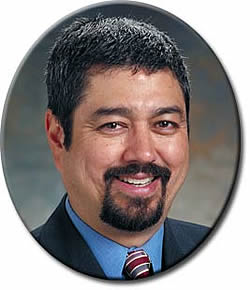John Cafaro - Chief Designer, C5 Corvette
 In 1965, John Cafaro Sr. took his ten year-old son and namesake to an auto show in New York. It was there that the future Chief Designer of the C5 first laid eyes on the Mako Shark. It's not hard to imagine that encounter, the Corvette concept car pulsating with ferocious beauty, the dark-haired boy leaning forward, eyes shining.
In 1965, John Cafaro Sr. took his ten year-old son and namesake to an auto show in New York. It was there that the future Chief Designer of the C5 first laid eyes on the Mako Shark. It's not hard to imagine that encounter, the Corvette concept car pulsating with ferocious beauty, the dark-haired boy leaning forward, eyes shining.
At that moment, as Cafaro would later recall, "I made up my mind I wanted to get into car design and go to GM."
The budding designer also knew that he "had to get involved with Corvette. I bought the models and the Matchbox cars" and, to his teachers' displeasure, passed the hours sketching cars on his school books.
After graduating from the Pratt Institute of Brooklyn, New York, Cafaro's sketches did him some good, landing him the job he had long dreamt of.
"I hadn't really thought that getting a job at GM was possible," Cafaro told Shark Quarterly's Wayne Ellwood in 1996. "Even once I got the interview, I didn't think I had done very well. I had been interviewed by Stan Wilen, and I had brought lots of finished sketches and a design for a minivan which was my major project in my final year. But I hadn't brought many working sketches because they generally don't look as good as a final rendering. Stan made me run home to my brownstone to get more working sketches just to stay in the process; it seems that he wanted to see how I worked, not just what the finished item looked like. I got a call the next day to say that I had won the job. I flew to Detroit the very next day and started immediately."
Cafaro plunged into a series of Camaro and Pontiac projects, and early in his tenure at GM was assigned to work on the 1984 Corvette under Jerry Palmer. Palmer's interest in Cafaro extended to helping his young protege secure the top spot in Chevrolet's premier design studio, Chevy 3 — the Corvette and Camaro studio.
The promotion was startling not just because of Cafaro's youth, but because of his often impolitic behavior. Refusing to stifle his opinions, the inexperienced new executive seemed to delight in publicly disagreeing with the brass, a habit that may have endeared him to his co-workers but not to many of his superiors.
 The Long Road to C5
The Long Road to C5
When Cafaro took over as chief of Chevy 3, it was the best and worst time to be a Corvette designer. The best because a whole new car was on the drawing board, holding out a tantalizing opportunity to leave a personal imprint on the legendary marque. But GM was in financial free-fall, and the very future of the Corvette and its proposed new generation, the C5, was in doubt.
In addition, Cafaro's boss, Chuck Jordan was threatening to take responsibility for th eC5 away from Chevy 3 and invited other company studios to submit designs, just to make sure that Cafaro felt the hot breath of competition on his neck.
For some seven years, Cafaro and his team labored on through corporate restructures and re-shufflings, literally being sent back to the drawing board repeatedly before producing a design that met with management's approval.
Then there were the myriad details to be worked out in conjunction with Dav Hill's engineers, and still, there was no guarantee that the C5 would see daylight.
The tortuous process of bringing the new Corvette to life was recorded by freelance writer and eyewitness, James Schefter, in his book, All Corvette Are Red. In it, he captures a pre-dawn moment in the office as "John Cafaro thought about his new car. Doing a Corvette from scratch was the dream of his career and hte assignment was finally his alone. This one would make or break Cafaro's reputation. He'd be forty-two years old when C5 hit the streets. it was still four years off and he could hardly wait. Turning forty meant nothing to John Cafaro, not when it was just a waypoint to C5.
"'We're getting there,' he muttered taking up a pencil and sketching new lines, modified line, for C5's broad butt end. ' It's really starting to take shape.'"
As every enthusiast knows, C5 finally did arrive in 1997, a rebirth of Amercia's true sports car, and "came into its own as globally recognized sports car of the highest status, on the street and on the racetrack," says Cafaro.
The new Corvette did make Cafaro's reputation. Still, the brash and insubordinate artist who became, in Schefter's words, "a smart executive" looks back on the C5 as his "once-in-a-lifetime achievement,: whose legacy was to "change how Corvettes would be designed, engineered and manufactured."
John Cafaro has come a long way, but in his impish grin you can still see a trace of the ten-year old who never lost his enthusiasm for the most exciting car he had ever seen—a Corvette.
